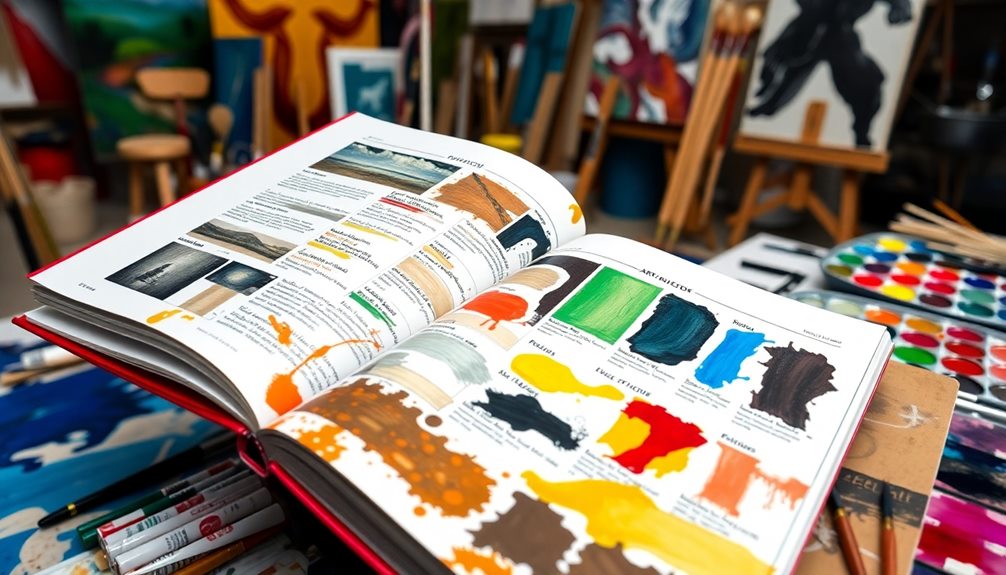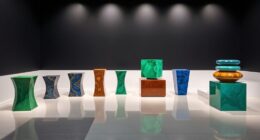Understanding key art appreciation terms enriches your experience with art. Familiarize yourself with concepts like medium, composition, and emotional impact. Recognizing focal points in a piece helps you grasp the artist's intent. Use techniques like formal and contextual analysis to deepen your insights. Learning about famous artworks like "The Starry Night" or "Girl with a Pearl Earring" offers real-world examples of these terms in action. Consider cultural context as it greatly influences interpretation and appreciation. By exploring these ideas, you'll discover new layers of meaning waiting for you in every piece.
Key Takeaways
- Understanding the medium of artwork helps identify the materials and techniques used by the artist.
- Recognizing composition aids in analyzing how visual elements are arranged within a piece.
- Emotional impact refers to how effectively an artwork evokes feelings in its viewers.
- Familiarity with focal points enhances the ability to identify areas of emphasis that draw attention.
- Engaging with cultural context reveals the historical and social influences that shape an artist's work.
Introduction

Why is art appreciation important? Engaging with art enhances your understanding and enjoyment of creative expressions, making it a vital part of cultural literacy.
When you delve into art appreciation, you start to recognize the historical, cultural, and social contexts surrounding each piece. This knowledge not only enriches your viewing experience but also promotes critical thinking, allowing you to analyze and interpret artworks on deeper levels.
Additionally, understanding the evolution of personal artistic style can further deepen your connection to different art forms and movements.
Art isn't just about what's on the surface; your emotional response to various themes and expressions within the artwork can create a personal connection. Whether it's joy, sadness, or nostalgia, these feelings often lead to more profound discussions about the work.
As you explore diverse artistic expressions from different cultures and time periods, you cultivate a broader understanding of the world around you.
Moreover, familiarizing yourself with key art terms and concepts can significantly enhance your conversations about art. You'll find that this deeper engagement transforms how you view and appreciate art, making each encounter more meaningful.
Embracing art appreciation not only enriches your life but also fosters a greater sense of empathy and connection to humanity's diverse narratives.
Key Concepts and Definitions

Understanding key concepts and definitions in art appreciation can significantly enhance your experience and discussions about art. One of the first terms you should know is medium, which refers to the materials used to create artwork. Whether it's oil paint, acrylics, or digital media, each medium offers unique qualities that affect the final piece.
Additionally, engaging in music-making fosters creativity, which can complement your artistic expression and appreciation.
Next, consider composition. This term describes how visual elements like lines, shapes, and colors are arranged in a work of art. A well-thought-out composition guides your eye and creates a sense of balance and harmony, making the artwork more engaging.
Don't overlook the emotional impact of art. This refers to how effectively a piece evokes feelings in you as a viewer. Factors like color palette, line quality, and subject matter play vital roles in this emotional connection, allowing you to engage on a deeper level.
Lastly, be aware of focal points. These are areas of emphasis that draw your attention within the composition, helping to guide the narrative and enhance visual interest.
Art Evaluation Techniques

Art appreciation doesn't just stop at recognizing key concepts; it also involves evaluating the artwork itself. When you dive into art evaluation techniques, you'll discover various methods to analyze the work before you.
One common approach is formal analysis, where you focus solely on the visual elements—like line, shape, color, texture, and space—without considering the surrounding context. This technique is particularly useful for understanding Abstract Art, as it emphasizes the composition itself. Additionally, employing strategies that encourage nurturing an imaginative mindset can deepen your engagement with the artwork and enhance your interpretative skills.
Alternatively, you might use contextual analysis, which examines the historical and cultural influences shaping the artwork. This approach can enhance your appreciation by revealing how the art form reflects its time and place.
Comparative analysis is another valuable technique. By placing artworks side by side, you can identify similarities and differences in style, technique, and themes, enriching your insight into various art movements.
Famous Artworks Analyzed
As you explore famous artworks, you'll find that each piece tells a unique story, reflecting the artist's emotions and the cultural context of its time.
Take Vincent van Gogh's "The Starry Night," for instance. Its swirling sky and bold colors demonstrate his emotional turmoil while showcasing innovative color theory.
In contrast, Salvador Dalí's "The Persistence of Memory" uses surreal imagery, like melting clocks, to symbolize the fluidity of time, revealing Freudian influences.
Johannes Vermeer's "Girl with a Pearl Earring" captivates through its masterful manipulation of light and dark, creating an intimate connection between the viewer and the subject.
Meanwhile, Leonardo da Vinci's "The Last Supper" employs linear perspective, expertly guiding your gaze toward Christ while capturing the varied emotional reactions of the apostles.
Tips and Best Practices

Exploring famous artworks offers a foundation for your journey into art appreciation, but knowing how to engage with them meaningfully takes your understanding to the next level. Start by considering the historical, cultural, and social contexts of each piece; this deepens your appreciation and enriches your insights.
Familiarize yourself with key terms like medium, texture, and composition. These concepts will help you analyze and discuss artworks more effectively.
Make it a habit to visit galleries and museums regularly. Experiencing diverse styles and movements allows you to form personal connections with different artistic expressions.
Don't hesitate to participate in art communities, workshops, or discussions. Engaging with fellow art enthusiasts expands your knowledge and offers fresh perspectives.
Keep a journal dedicated to your reflections on the artworks you encounter. This practice not only tracks your growth in art appreciation but also helps you articulate your emotional responses.
Viewer Engagement and Feedback

Engaging with artwork goes beyond passive observation; it invites you into a dialogue that can enhance your appreciation and understanding. As a viewer, you must actively analyze the elements and techniques used in each piece. This active observation encourages you to create a sense of connection with the artwork, allowing you to uncover deeper meanings and emotions.
Providing constructive feedback is crucial in this process. When you share your thoughts on an artwork, you contribute to a richer dialogue about its emotional and conceptual impact. Your perspective, shaped by personal and cultural experiences, adds depth to the discussion and enriches the overall appreciation of the piece.
Participating in workshops or guided tours can further enhance your engagement. These experiences offer insights into historical context and artistic techniques, helping you appreciate the nuances of the work.
Remember, your feedback is valuable not just for your understanding but also for the artists. It informs their creative process and helps them connect more deeply with their audience.
Cultural Context Impacts Interpretation

Cultural context shapes how you interpret and appreciate artwork, influencing your understanding of its deeper meanings. When you consider the historical, social, and political environments surrounding a piece, you unlock insights into the artist's intentions and the societal norms or issues they addressed. This understanding enhances your connection to the artwork.
Different cultures assign varying significance to elements like color, symbolism, and technique. If you engage with these cultural nuances, you might discover new layers of meaning that alter your interpretation.
For example, an art movement often arises in response to cultural shifts, reflecting the values and concerns of that era. Recognizing these connections can deepen your appreciation for both the art and the time in which it was created.
Additional Resources

Understanding the cultural context of artwork opens up a wealth of resources that can further enrich your appreciation. To dive deeper into art, consider exploring art history books like "The Story of Art" by E.H. Gombrich. This book offers foundational knowledge about significant movements and artists throughout history.
You can also take advantage of online courses on platforms like Coursera and Khan Academy, which provide free art appreciation courses covering essential concepts and terminology.
Many museums enhance your learning experience by offering educational materials and virtual tours, allowing you to explore their collections and the context behind the artworks.
Listening to art-focused podcasts and watching documentaries are excellent ways to deepen your insights into specific artists, movements, and techniques.
Additionally, engaging with local art groups or online forums helps facilitate discussions and exchanges of ideas, making your journey into art even richer.
Frequently Asked Questions
What Is the Term for Appreciating Art?
The term for appreciating art is "art appreciation." It involves engaging with artworks, understanding their emotional impact, and recognizing historical and cultural influences. You can enhance your experience by analyzing and interpreting various artistic expressions.
What Are the Main Topics of Art Appreciation?
The main topics of art appreciation include understanding key elements like line, shape, color, and texture. You'll explore historical contexts, analyze emotional responses, and engage with various art movements that shape artistic expression.
Which Are Key Terms to Finding Meaning in Art?
To find meaning in art, focus on the medium, composition, color palette, texture, and emotional narrative. These elements help you understand the artist's intent and enhance your connection to the artwork's story and impact.
What Is the Most Important in Art Appreciation?
In art appreciation, understanding context is vital. It shapes your interpretation and connection to the artwork. Don't forget to engage emotionally and think critically; these elements deepen your experience and enrich your overall appreciation.
Conclusion
In conclusion, understanding art appreciation terms enhances your experience and connection with art. By familiarizing yourself with key concepts and evaluation techniques, you'll feel more confident in analyzing famous artworks and sharing your insights. Remember to engage with others and consider cultural contexts, as they shape interpretations. Don't hesitate to explore additional resources to deepen your knowledge. Art is a journey, and with these tools, you're well-equipped to enjoy every step of the way!









